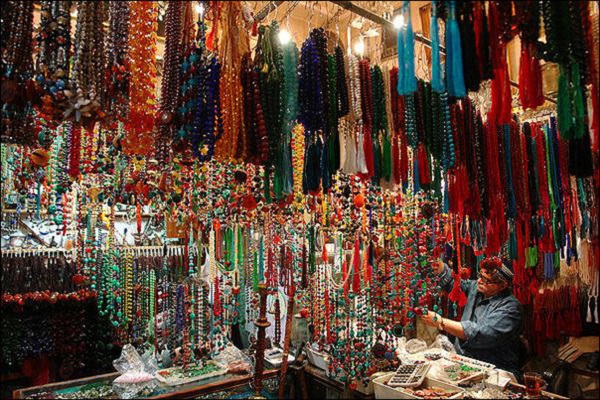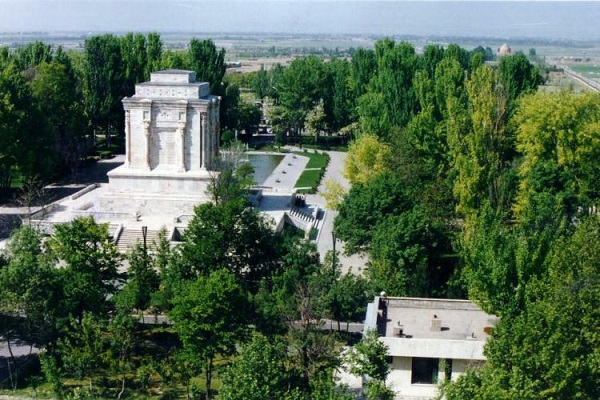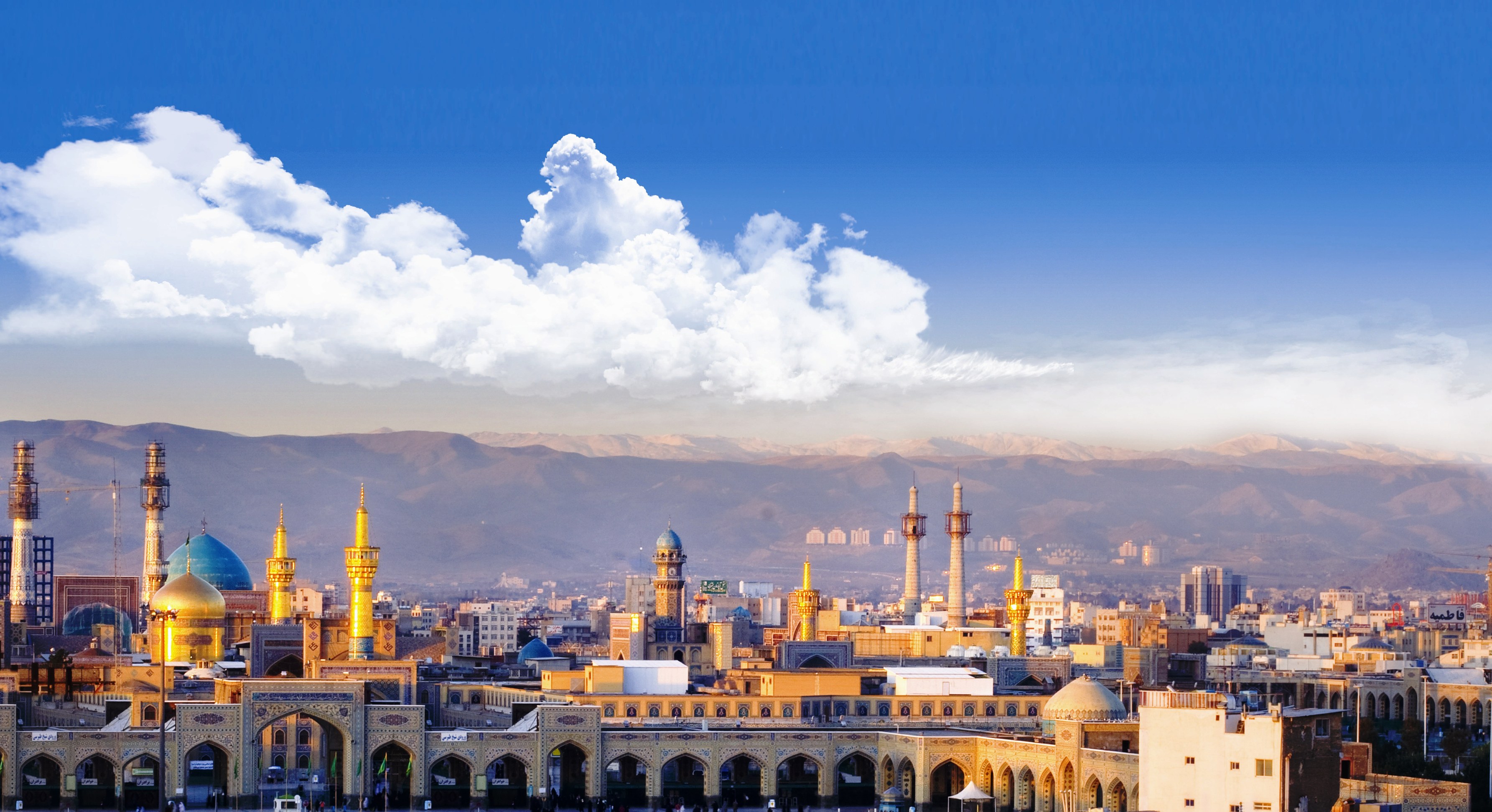As the first holy city, Mashhad is of extreme significance to the Shia world. This, of course, is due to the glory of Imam Reza’s shrine which is highly remarkable for its religious, architectural and historical notions, so that approximately 2 million pilgrims from all corners of the Shia world annually come to visit this very sacred place.
The souvenirs of Mashhad divide into edible souvenirs and handicrafts. The edible souvenirs of Mashhad are Saffron, Barberry, Dried fruits, Adviyeh Haft Ghalam (seven-item spice) it is a mixture of cinnamon, sumac, Golpar (Persian hogweed), ginger, black pepper, red pepper and turmeric, Nabat and Noghl, and Jili Bili. Mashhad’s handicrafts are Perfume, Jewelry and turquoise stone, Fur cloth sewing, Hara Kareh (stone cauldron), Samovar making, Felted products, and Exquisite silver panels.
The most famous visiting sights of this historic and religious city are Imam Reza shrine, Mashhad Bazaar, Tomb of Ferdowsi, Kooh Sangi, Mashhad botanical garden, and Mellat Park. All of these sights are explained briefly below.
Let’s start with the most religious sight of Iran, Imam Reza shrine. Imam Reza is the 8th Imam of Shia people and is known to be Imam of knowledge. His shrine is located in Mashhad and is the largest mosque in the world. Also known as “The Heart Of Shia”, Imam Reza shrine is one of the tourism centers in Iran and visiting this holy shrine is recommended to the Islam lovers.it hosts approximately 12 million foreigners and native tourists yearly.

As you know Iran is famous for its old Bazaars. In our Bazaars, you can find some awesome local souvenirs explained above. You can also meet friendly people who love tourists and appreciate new cultures. You will also be surrounded by the Persian spectacular architecture of our Bazaars. Don't forget to pay a visit to Mashhad Bazaar on your Iran tourism.

Built-in the 1930s, the structure of the Tomb of Ferdowsi is very similar to Achaemenid architecture to represent our rich culture and history to the whole world. This tomb was built to honor our famous poet Ferdowsi the writer of the Shah-name (the book of kings) who changed out literature by his marvelous poems.

Placed between two Mountains, Kooh Sangi is the third most visited site after Imam Reza shrine and Tomb of Ferdowsi in Mashhad. If you need some hours to relax and enjoy good weather with your family or friends this is the perfect spot go you.
Mashhad Botanical Garden includes different sections such as rose garden, educational garden, Iranian plant garden, arboretum and systematic plant collection, Iranian native garden of fruits, folk arboretum collection, rock garden collection, nursery, and greenhouses. This garden was built to protect and preserve plants and also to help students and citizens to learn about the variety of plant species. If you are a fan of green life and plants make sure to visit Mashhad Botanical Garden in your Iran travel
I don’t think any of you don’t want a little fun and excitement. If you are a fan of amusement parks like me, you are welcomed in the Mashhad’s biggest park, the Mellat Luna Park. Mellat Luna Park consists of so many thrilling games that would bring horror and laughter to your faces.
If you want to travel to these sights we recommend you to travel on tours. If you want an English speaking native guide to accompany you on your memorable trip you can contact us. We will arrange everything for your Iran visit.
As one of the well-known and trusted Iran travel agencies in the world, we are proud to show Iran's spectacular sights to our kind passengers. As for Mashhad's sights, our Iran religious tour package passes this famous city and in this package, we will take you to all of these unique sights explained above. Glory and adventure are waiting for you, all you have to do is to contact us.
In the year 202 AH, after the martyrdom of Imam Reza (AS) in a place around Tous called Sanabad which came to be known as Mashhad-e-Reza (Place of Martyrdom) the main nucleus of today or the present Mashhad came into existence. Sultan Mahmud of Ghazni built a mausoleum on the shrine. Due to the destruction of the city of Tous in the 7th century AH, people flocked to the city of Mashhad. At first, the area of Tous was inhabited by non-Aryans and some parts of it was conquered by the Arabs during the reign of the Caliph Osman. It was annexed to the Islamic territory in the time of Caliph Omar. The city of Tous was one of the first to be plundered and destroyed like the other cities of Khorasan by the Mongols. The city of Tous due to its delicate and sensitive position was subject to upheavals during the Timurid Empire and Ilkhanate period. Being passed through, hand to hand between different governments, people were massacred. Ultimately in the year 807 AH, Shah Rukh, the son of Amir Timur ascended the throne and since then Tous has developed and thrived, and from the second half of the 9th century AH, it came to stand as a suburb of Mashhad. Ruins of the old city of Tous have come to remain. But the present-day Tous has guarded its importance since the tomb of the great Iranian poet Ferdowsi is located there. However, today Mashhad has an unbreakable link with the history of ancient Tous and annually hosts thousands of pilgrims and visitors and is one of the focal points of pilgrims for the Shia.

Mashhad is located in a valley between two mountain ranges, the valley of the Kashaf River. As with many cities located in intermountain valleys, access to underground aquifers is through a series of canals qanāt drilled down into the slopes of the mountains. The metropolitan area is subject to earthquakes, and seismic activity in outlying areas, such as Qāyen in 1997 and Bam in 2008, has also been recorded in Mashhad.
The city is laid out in a roughly circular shape, with the religious edifices and monuments located in the center of Khorasan province and avenues radiating outward to approximately 12 neighborhoods, such as Malikābād, Sajjād,
Shahrak-e Azadi, Kuy-e Imām Riḍā, and Sīsābād. Mashhad differs from other Iranian cities in that a shrine—in this case, the one marking the burial place of ʿAlī al-Riḍā—rather than a bazaar constitutes the center of muni
